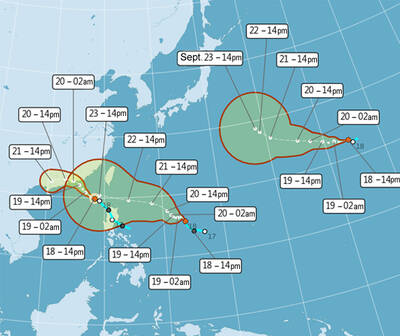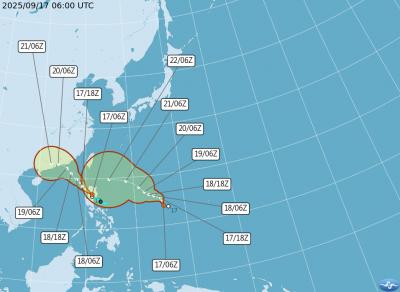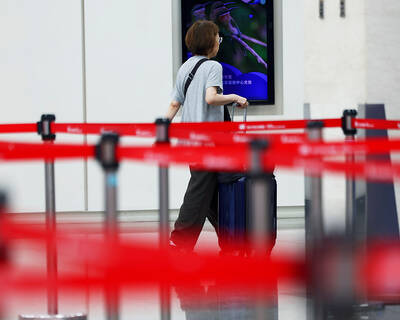Travelers will probably not get lost as easily at Taiwan Taoyuan International Airport anymore because the Taoyuan International Airport (TIA) Corp is in the process of replacing the signs at its first and second terminals with ones with clearer directions.
TIA president Samuel Lin (林鵬良) said the airport company has listed sign improvement as one of its most important projects this year. He said the current airport signs lack consistency in style. Some of them have pointed flight passengers in the wrong direction because they were placed in inappropriate locations, he said.
When the government began to renovate the first terminal in 2009, Lin said that the company hoped to simultaneously push for more user-friendly signs with consistent designs.
To facilitate replacing the signs, Lin said that the company decided to learn from Hong Kong International Airport because a large percentage of passengers in Taiwan and Hong Kong overlap. Customers will feel more at home if they see similar signs at these airports, he said.
Lin said the CEO of Hong Kong International Airport gave two free lectures to the employees of Taoyuan airport.
“Both airports [Taiwan and Hong Kong] have their signs displayed in both English and traditional Chinese characters,” Lin said. “The airport in Hong Kong has accumulated many years of experience since it was officially opened in 1998 before it decided to change to the current design three years ago. We could use their signs as a reference.”
Currently, the signs in Taoyuan airport are either yellow or white print on a black background.
Lin said the signs in the Taoyuan airport will be displayed in white print on a blue background. Those for airport facilities, such as restrooms and restaurants, will have white print on a dark red background instead.
Because some traditional -Chinese characters look similar if they are viewed from a distance, such as the Chinese words for “garden” (園) and “country” (國), Lin said that the Hong Kong Airport has decided to have the Chinese characters printed in “Imitation Song” style (仿宋體), which is a script typeface modeled after the characters used during the Southern Song Dynasty.
“[Because of the change in font] Passengers can clearly see the words on the signs even if they view them from 30m away,” Lin said, adding that Taiwan will also adopt the “Imitation Song” style for the new signs.
Lin said airport passengers could start seeing the new signs displayed at the first terminal in August. All the signs in the first and second terminals will be changed by the end of next year.

PEAK MONTHS: Data showed that on average 25 to 27 typhoons formed in the Pacific and South China seas annually, with about four forming per month in July and October One of three tropical depressions in the Pacific strengthened into a typhoon yesterday afternoon, while two others are expected to become typhoons by today, Central Weather Administration (CWA) forecaster Lee Ming-hsiang (李名翔) said yesterday. The outer circulation of Tropical Depression No. 20, now Typhoon Mitag, has brought light rain to Hualien, Taitung and areas in the south, Lee said, adding that as of 2pm yesterday, Mitag was moving west-northwest at 16kph, but is not expected to directly affect Taiwan. It was possible that Tropical Depression No. 21 would become a typhoon as soon as last night, he said. It was moving in a

A Taiwanese academic yesterday said that Chinese Ambassador to Denmark Wang Xuefeng (王雪峰) disrespected Denmark and Japan when he earlier this year allegedly asked Japan’s embassy to make Taiwan’s representatives leave an event in Copenhagen. The Danish-language Berlingske on Sunday reported the incident in an article with the headline “The emperor’s birthday ended in drama in Copenhagen: More conflict may be on the way between Denmark and China.” It said that on Feb. 26, the Japanese embassy in Denmark held an event for Japanese Emperor Naruhito’s birthday, with about 200 guests in attendance, including representatives from Taiwan. After addressing the Japanese hosts, Wang

One of two tropical depressions that formed offshore this morning could turn into a moderate typhoon by the weekend, the Central Weather Administration (CWA) said today. Tropical Depression No. 21 formed at 8am about 1,850km off the southeast coast, CWA forecaster Lee Meng-hsuan (李孟軒) said. It is expected to move in a northwesterly direction as it continues building momentum, possibly intensifying into Typhoon Mitag this weekend, she added. The radius of the storm is expected to reach almost 200km, she said. It is expected to approach southeast of Taiwan on Monday and pass through the Bashi Channel between Tuesday and Wednesday,

About nine Taiwanese are “disappeared,” detained, or otherwise deprived of freedom of movement in China each month, the Mainland Affairs Council (MAC) said yesterday. Between Jan. 1 last year and Aug. 31 this year, 188 Taiwanese travelers went missing, were detained and interrogated, or had their personal freedom restricted, with some questioned in airports or hotel lobbies, the council said. In a statement ahead of the Mid-Autumn Festival, the council urged people visiting China for any reason to be highly vigilant and aware of the risks. Of the reported cases, 50 people were “disappeared” after entering China, 19 were detained and 119 had